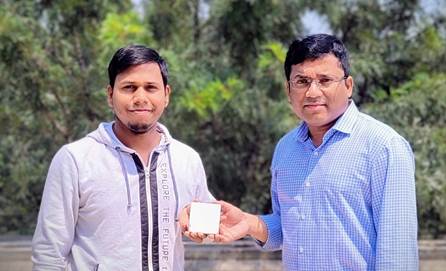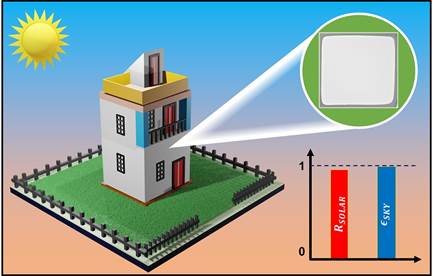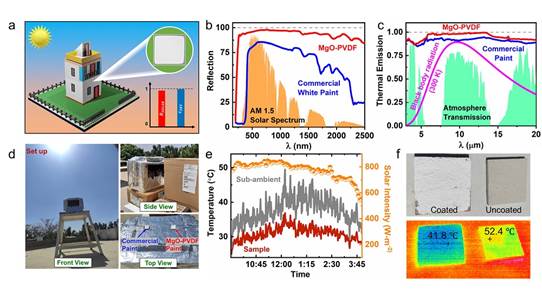Newly developed affordable radiative paint can reduce electricity consumption for cooling buildings
A new affordable, eco-friendly radiative cooling paint, specifically engineered to effectively cool structures like buildings, pavers, and tiles in hot weather conditions can diminish electricity consumption and offer essential relief during sweltering summer days.
Cooling technologies are an integral part of human life due to the increased global warming and urban heat island effects. Active cooling devices such as air-conditioners (AC), electric fans, and refrigerators consume enormous electrical energy. Along with this vast energy demand, active cooling devices also emit a large proportion of greenhouse gases, leading to an increase in the earth’s surface temperature. To circumvent these challenges, radiative cooling technology has been developed that provides cool surfaces by emitting thermal radiation directly to the cold universe (around 3K) through the atmospheric transmission window (8 – 13 µm) without electricity consumption. As a result, passive daytime radiative cooling (PDRC) has drawn much interest recently for many applications such as pavers, tiles, building and automobile cooling, solar cell, and personal thermal management.
At the Jawaharlal Nehru Centre for Advanced Scientific Research (JNCASR) in Bengaluru, researchers, led by Professor Bivas Saha in collaboration with Prasanna Das, Sourav Rudra, Krishna Chand Maurya, have introduced a groundbreaking radiative cooling paint. Developed from a novel MgO-PVDF polymer nanocomposite, this low-cost, solution-processed paint demonstrates significant cooling capabilities with an high solar reflectivity and infrared thermal emissivity. The experimental findings by scientists of JNCASR, an autonomous institute of the Department of Science and Technology, have shown that the surface temperature of a treated paver decreases by approximately 10°C under intense sunlight– almost double of the reduction that conventional white paints give.
The researchers developed polymer nanocomposite paint by using a simple solution-processed technique. They used ultra-white and ultra-emissive magnesium oxide (MgO)-polyvinylidene fluoride (PVDF) nano-composite prepared from materials that are earth abundant, cheap, non-toxic and non-harmful. Initially, polymer powders were transformed into a solution using solvent and then, dielectric nanoparticles are dispersed inside the polymer matrix. After preparation, different spectroscopic techniques were used to characterize the optical properties of the prepared polymer nanocomposite paint. By measuring the temperature of the paint using a thermocouple, excellent cooling performance was demonstrated under hot sunlight.
The optimized MgO-PVDF with a dielectric nanoparticles resulted in large solar reflectance of 96.3% and a record high thermal emission of 98.5% due to Mg─O bond vibrations, and other stretching/bonding vibrations from the polymer. The nanocomposite paint exhibited water-resistant hydrophobic properties and can be easily coated on pavers, wood sticks and so on with high uniformity and good adhesion.
“Our innovative research has led to the development of a cost-effective and environmentally sustainable paint capable of reducing surface temperatures (including buildings, tiles, pavers, etc.) by over 10°C during hot summer days. With the straightforward application of this paint, we envision it offering significant respite during scorching summer days, benefiting both urban and rural areas alike.” said Prof. Bivas Saha, Associate Professor at the Jawaharlal Nehru Centre for Advanced Scientific Research.
The work published in Advanced Material Technologies, a Wiley publication, can motivate industries to implement the radiative cooling paint for building cooling applications. These findings indicate that the adoption of MgO-PVDF cooling paint in construction can significantly curtail the reliance on air conditioning, thus contributing to a reduction in associated environmental impacts.


Figure: The realization of a low-cost, hydrophobic, solution-processed nanocomposite radiative cooling paint would address the urban heat island effects, especially in equatorial regions, southeast Asia, middle-east, and Africa. Here, MgO-PVDF nanocomposite paint is developed with ultrahigh solar reflectance (96.3%) and record-high thermal emissivity (98.5%), exhibiting a temperature decrease of ~ 10
 highlighting its remarkable radiative cooling performance.
highlighting its remarkable radiative cooling performance.

Fig. 1: (a) Schematic of a building painted with radiative cooling paint. (b) The reflection spectra of MgO-PVDF coating and a commercial white paint along with AM 1.5 solar spectrum. (c) The thermal emission spectra of MgO-PVDF composite film, commercial paint, blackbody (BB) spectrum at 300K, and atmospheric transmission profile are shown. (d) Photo of the radiative cooling measurement setup employed for the field test on a flat roof in Bangalore, India. (e) The outdoor real-time cooling results of the MgO-PVDF coating with respect to sub-ambient. (f) Photograph and thermal image of a coated and an uncoated ceramic paver at outdoor.

